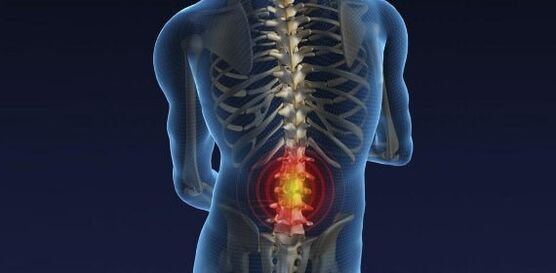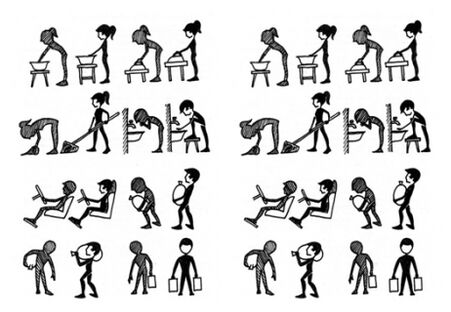
Back and limbs are one of the most common disorders.This is the second most common cause of medical treatment after respiratory disease.At their age, about half of the working people endure episodes of back pain and long -lasting disability.
What is osteochondrosis
Osteocondrosis is a disease in which degeneration between the vertebrae occurs.
The intervertebral disk consists of a fibrous ring (concentric layers of strong connective tissue fibers) and a jacket.The ratio of the plates is about a quarter of the spine length, playing a root absorbers - in the upright position, by turns, inclination and spine extension, the core and the fibrous river, which uses axial loads, which occupies a starting position.Significant load on the lumbar and cervical spine plate as these classes have the highest mobility.This explains the greatest severity of degenerative changes in the cervix and lumbar spine.
One of the causes of degeneration of discs is inadequate nutrition, which in turn is a result of human physical activity.
The water content and the elastic properties of the disk are also significantly reduced with age.The fibrous ring of the plate loses its elasticity, with cracks appearing in which the coat seeds are increasingly introduced at each new load and moves to the edge of the plate, and the contents of the core exceed the limits - with jacket nucleus hernia.More often, the lateral displacement of the disc occurs towards the intervertebral hole through which the spinal cord passes through.In this regard, the most common manifestation of the hernia is to press the formation of the right root and characteristic pain syndrome.The impulses from the receptors of the affected segment cause the spine muscles reflexively tension, their asymmetric stress causes the lateral curvature of the spine
The risk factors of osteochondrosis
Currently, the risk factors for the occurrence of osteochondrosis pain are as follows:
- hereditary weakness or congenital errors of the spine;
- spine injuries that lead to structural changes;
- difficult and unbalanced physical activity;
- Long stay in forced pose, with distortion and turning;
- Hypodynamia, inactivity, monotonous work.
Contributing factors in the occurrence of osteochondrosis and its aggravations can be various infectious diseases, cooling, overtime, energy, including vitamins, obesity, environmental factors and customs, endocrine disorders, etc.
What to do if your back is sick
Pain is a warning sign and protects damage from the effects inside the body.First, the pain occurs when the pain, when the posture changes, and the rest of the rest, and as the disease progresses, the morning stiffness appears, which can last 30-60 minutes.The duration of the disease may be a few weeks or months.
What to do if the back pain?Be sure to seek medical attention in the first 3-5 days (to avoid chronic the disease).Use simple tips for your doctor's recommendation:
- Overload should be avoided.To avoid problems, try to keep an eye on the correct position of the body.Excessive weight increases the load on the spine.Not all sports are the same useful.It is better to avoid the game's sport, the jump, and choose hiking, skis and swimming - these are only for the benefit of the spine.

- Organize sleep, food and relaxation correctly.For maximum effect, choose a fairly hard mattress and an orthopedic pillow will be the best choice.
- Organize your workplace correctly.A low seat chair that leans towards the back and which must be convex on the lumbar spine (or is recommended to lay a roller) will be ideal.
- Situation management.With a rather high roller built during the lower lumbar lordosis, the "tense" muscles rest, the pressure on the back of the lumbar spine is reduced and the pain is reduced.After working day, it is advisable to spend 30-60 minutes in this situation at home before going to bed.
- Therapeutic gymnastics (exercise therapy).Gymnastics forms a strong muscle lining around the spine and translates 15-25 minutes a day (2-3 approaches).The set of exercises should be prescribed by the treating physician, depending on the intensity of the pain, depending on the period of the disease at the end of the article, the most common complexes of therapeutic exercises (acute phase, remission, etc.)
Motor mode recommendations in acute period
In an acute periodIn the presence of acute pain, a strict bed should be held.LFK is primarily used for hygienic purposes and is a general amplifier in nature.Pain -causing exercises in the amplitude, the degree of muscle tension, or at all should not be excluded.It is very important not to participate in pain and do everything very slowly, to repeat every exercise 8-10 times.
When moving the lower limbs, they prevent lumbar lordosis (leaning in the spinal column), which can improve the pain syndrome.In the second phase of the acute period, with a decrease in pain intensity, it should be carefully included in the preparation of the abdominal muscles and large gluteal muscles.
With a decrease in pain syndromeThe possibilities of using special and developmental practices are increasing.During this period, in addition to exercises that increase the strength of the abdominal muscles and hip muscles, exercises are important with bending the lumbar spine.
When choosing special and developing exercises, it is important to ensure that they do not increase lumbar lordosis.A sign of pain is to change or exclude the structure of the exercise (towards relief).At the end of the second period, you need to gradually attract exercises that increase the strength of the rear muscles, which can be performed 2-3 times in a circular system.They are the most important.Remove the number of special exercises 15-50 times.The rate of exercise can be gradually increased.
During the period of remissionPractices to increase the mobility of the spinal column are added.However, exercises to solve the problem should be carefully and in an easy starting position.Automism should be achieved by maintaining a particular posture and walking when the lumbar spine is bent, maintained by maintaining a particular posture.Reducing repetitions of the second period increases to 50-100 (interrupted during the day).The use of exercise therapy in the pelvis is recommended for the period, but the pelvis gymnastics does not replace, but complements the main "dry" classes.
Other means of exercise therapy is recommended for use that do not affect the negative methods of damaged discs: swimming, terrenur, skiing, running road, bicycle -ergometer, rubber bandage exercises.Apply devices such as volleyball, tennis (big and small), road bikes, cross -country runs, fast dance, rhythmic gymnastics, as sudden movements and turns can cause aggravation of osteochondrosis.Practices with dumbbells are preferably performed in the lying (back, abdomen) position to exclude vertical load on the spine.
Due to the strong tension of the body's longer muscles, pure hanging exercises, jumping into the height, rowing and throwing are undesirable.In any case, during exercise treatment, it should be remembered that permanent spine injury and overload, along the spine axis, prepare the proper background to break down the damaged plate and worsen the pain syndrome.























